Module 1
1. Module 1
1.16. Page 4
Module 1—The Nervous System
 Watch and Listen
Watch and Listen
If you would like more review of reflexes, watch the following segments of the video “Reflexes and Synaptic Transmission: Getting the Message Across.”
- “Introduction”
- “Patellar and Pupillary Reflex”
- “Bio Probe: Checkstop”
- “Is Response Time Affected by Different Types of Stimuli?”
- “Bio Review: Conditioned vs. Simple Reflexes”
- “Reflex Arc”
- “Description of a Simple Reflex Arc”
- “Bio Fact: Typical Reflex Arc”
You may be prompted to provide a username and password in order to access the video. Contact your teacher for this information.
You can also check out an interesting applet about reflexes on the BBC website. You can use search words such as “bbc,” “schools,” “bite size,” and “bireflexarc.”
 Self-Check
Self-Check
SC 2. To review your understanding of the reflex arc, write a step-by-step description of the process illustrated below using all the terms that you have learned, and then name the type of reflex involved. Also provide a description of each numbered part of the diagram.

Inquiry into Biology (Whitby, ON: McGraw-Hill Ryerson, 2007), 370, fig. 11.8. Reproduced by permission.
 Self-Check Answers
Self-Check Answers
SC 2.

A withdrawal reflex is shown. Receptors in the skin perceive the stimulus (the cactus). Sensory information is conducted from the senses into the spinal cord. Motor information is then conducted away from the spinal cord to the muscles and glands.